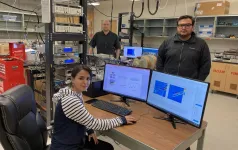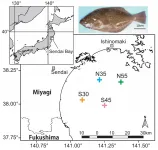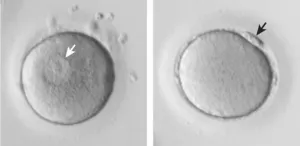Researchers use a nanoscale synthetic antiferromagnet to toggle nonlinear spin dynamics
UC Riverside-led work could lead to better computer technologies
2021-04-28
(Press-News.org) RIVERSIDE, Calif. -- Researchers at the University of California, Riverside, have used a nanoscale synthetic antiferromagnet to control the interaction between magnons -- research that could lead to faster and more energy-efficient computers.
In ferromagnets, electron spins point in the same direction. To make future computer technologies faster and more energy-efficient, spintronics research employs spin dynamics -- fluctuations of the electron spins -- to process information. Magnons, the quantum-mechanical units of spin fluctuations, interact with each other, leading to nonlinear features of the spin dynamics. Such nonlinearities play a central role in magnetic memory, spin torque oscillators, and many other spintronic applications.
For example, in the emergent field of magnetic neuromorphic networks -- a technology that mimics the brain -- nonlinearities are essential for tuning the response of magnetic neurons. Also, in another frontier area of research, nonlinear spin dynamics may become instrumental.
"We anticipate the concepts of quantum information and spintronics to consolidate in hybrid quantum systems," said Igor Barsukov, an assistant professor at the Department of Physics & Astronomy who led the study that appears in Applied Materials & Interfaces. "We will have to control nonlinear spin dynamics at the quantum level to achieve their functionality."
Barsukov explained that in nanomagnets, which serve as building blocks for many spintronic technologies, magnons show quantized energy levels. Interaction between the magnons follows certain symmetry rules. The research team learned to engineer the magnon interaction and identified two approaches to achieve nonlinearity: breaking the symmetry of the nanomagnet's spin configuration; and modifying the symmetry of the magnons. They chose the second approach.
"Modifying magnon symmetry is the more challenging but also more application-friendly approach," said Arezoo Etesamirad, the first author of the research paper and a graduate student in Barsukov's lab.
In their approach, the researchers subjected a nanomagnet to a magnetic field that showed nonuniformity at characteristic nanometer length scales. This nanoscale nonuniform magnetic field itself had to originate from another nanoscale object.
For a source of such a magnetic field, the researchers used a nanoscale synthetic antiferromagnet, or SAF, consisting of two ferromagnetic layers with antiparallel spin orientation. In its normal state, SAF generates nearly no stray field -- the magnetic field surrounding the SAF, which is very small. Once it undergoes the so-called spin-flop transition, the spins become canted and the SAF generates a stray field with nonuniformity at nanoscale, as needed. The researchers switched the SAF between the normal state and the spin-flop state in a controlled manner to toggle the symmetry-breaking field on and off.
"We were able to manipulate the magnon interaction coefficient by at least one order of magnitude," Etesamirad said. "This is a very promising result, which could be used to engineer coherent magnon coupling in quantum information systems, create distinct dissipative states in magnetic neuromorphic networks, and control large excitation regimes in spin-torque devices."
INFORMATION:
Barsukov and Etesamirad were joined in the research by Rodolfo Rodriguez and Joshua Bocanegra of UCR; Roman Verba and Boris Ivanov of the Institute of Magnetism in Ukraine; Jordan Katine of Western Digital at San Jose; Ilya N. Krivorotov of UC Irvine; and Vasyl Tyberkevych of Oakland University in Michigan.
The work was supported by the National Science Foundation. Any opinions, findings, and conclusions or recommendations expressed in this material are those of the authors and do not necessarily reflect the views of the National Science Foundation.
The research paper is titled "Controlling Magnon Interaction by a Nanoscale Switch."
The University of California, Riverside (http://www.ucr.edu) is a doctoral research university, a living laboratory for groundbreaking exploration of issues critical to Inland Southern California, the state and communities around the world. Reflecting California's diverse culture, UCR's enrollment is more than 25,000 students. The campus opened a medical school in 2013 and has reached the heart of the Coachella Valley by way of the UCR Palm Desert Center. The campus has an annual statewide economic impact of almost $2 billion. To learn more, email news@ucr.edu.
[Attachments] See images for this press release:

ELSE PRESS RELEASES FROM THIS DATE:
2021-04-28
Collagen is a protein found widely in almost all cells of animals, and scientifically can be used to learn much about an animal's life history including human being in the present or in the past. Scientists at the Research Institute for Humanity and Nature (RIHN) and Japan Fisheries Research and Education Agency (FRA), Japan, prove this point for Japanese flounder by measuring isotope ratios in vertebral-bone collagen. The new study, which can be read in Marine Biology, shows that there exist behavioral groups of fish with different migrating and/or feeding patterns.
A school of fish will decide their habitat on fundamental needs for survival, ...
2021-04-28
Researchers at the National Food Institute have come up with a solution that can help combat both food loss and food waste: They have generated a natural lactic acid bacterium, which secretes the antimicrobial peptide nisin, when grown on dairy waste.
Nisin is a food-grade preservative, which can extend the shelf life of foods, and thus can be used to reduce food waste. The discovery also makes it possible to better utilize the large quantities of whey generated when cheese is made.
Nisin is approved for use in a number of foods, where it can prevent the growth of certain spoilage microorganisms as well as microorganisms that make consumers sick. It can for instance inhibit spore ...
2021-04-28
The target of carbon-neutral and net-zero emissions is the development and utilization of renewable energy. High-energy-density energy storage systems are critical technologies for the integration of renewable energy.
Li metal is highly recognized as a promising alternative anode for next-generation rechargeable batteries due to its high theoretical capacity of 3860 mAh g-1 and ultralow electrode potential of -3.04 V compared to the standard hydrogen electrode.
However, Li metal batteries' (LMBs) main issue is their low Coulombic efficiency (CE), which limits batteries' cycle life. The low CE in LMBs occurs ...
2021-04-28
Age may adversely affect women's fertility by impairing levels of RNA molecules which in turn alter the function of genes involved in key biological pathways during the final maturation stage of a human egg cell, according to the findings of a new study published today in the journal Aging Cell.
Researchers from the Centre for Genomic Regulation (CRG), the Centro Nacional de Análisis Genómico (CNAG-CRG) and Clínica Eugin sequenced the RNA molecules, also known as the transcriptome, within oocytes to understand which genes are affected in their activity by age. They used single-cell sequencing to analyse the transcriptome of 72 individual oocytes ...
2021-04-28
BUFFALO, N.Y. -- A national, University at Buffalo-led study on genes in pediatric cardiomyopathy demonstrates strong evidence for routine genetic screening in children with the disease. The study, published April 28 in the Journal of the American Heart Association, revealed wide variation in screening, with some centers conducting routine genetic testing and others conducting none.
Conducted at 14 centers, the National Institutes of Health-funded study of 152 children with cardiomyopathy found that only half had undergone genetic screening. Of those who hadn't undergone screening, 21% were found to have a genetic cause for the ...
2021-04-28
Under normal, healthy circulatory conditions, the von Willebrand Factor (vWF) keeps to itself. The large and mysterious glycoprotein moves through the blood, balled up tightly, its reaction sites unexposed. But when significant bleeding occurs, it springs into action, initiating the clotting process.
When it works properly, vWF helps stop bleeding and saves lives. However, according to the Centers for Disease Control and Prevention (CDC), about 60,000 to 100,000 Americans die each year from thrombosis, a disorder characterized by too much clotting. Blood clots can trigger a stroke or heart attack.
According ...
2021-04-28
Today at the Microbiology Society's Annual Conference, Yang Liu, researcher at Hong Kong Polytechnic University, will discuss a new technique to trap and recover microplastics.
The method uses bacterial biofilms, a sticky substance created by micro-organisms, to trap microplastic particles. The biofilm is then processed and dispersed, releasing the microplastic particles for processing and recycling.
Liu and colleagues used the bacterium Pseudomonas aeruginosa to capture microplastics in a bioreactor. This species of bacteria is found in all environments and has previously been shown to colonise microplastics in the environment.
P. aeruginosa biofilms ...
2021-04-28
Research shows that children who experience puberty earlier than their peers are more likely to begin drinking alcohol at a young age and early alcohol exposure is also known to be related to alcohol dependence later in life. Specifically, adolescents who mature early are two to three times more likely to drink than other youth. In addition, early maturing girls are two to three times more likely to drink until intoxication and three times as likely to have an alcohol use disorder. A new study examined why early developing 14-year-old adolescents are more likely to drink alcohol compared to those whose pubertal development is on-time or late. The findings show these adolescents are more likely to have ...
2021-04-28
Frequent use of exemptions may undermine public health protections of oil and gas setback policies, according to a new study led by researchers at the research institute PSE Healthy Energy, Harvard University, and Nicholas Institute for Environmental Solutions at Duke University. The study, published April 28, 2021 in Energy Policy, is the first to assess the effectiveness of distance-based setback regulations for unconventional natural gas development (UNGD) or "fracking."
"Setback regulations are commonly employed to protect public health, so we wanted to test if they're effective in practice," said lead author Drew Michanowicz, DrPH, ...
2021-04-28
In a new nationwide poll, the GeneSight® Mental Health Monitor found that 83% of people with depression agree that life would be easier if others could understand their depression. Yet, most people who have not experienced depression may not be able to understand the challenges, including its treatment.
"Depression is one of the most misunderstood disorders. When people misinterpret patients with depression as 'lazy' or 'dramatic,' they are vastly underestimating and misunderstanding the debilitating symptoms of major depressive disorder," said Mark Pollack, M.D., chief medical officer for the GeneSight test at Myriad ...
LAST 30 PRESS RELEASES:
[Press-News.org] Researchers use a nanoscale synthetic antiferromagnet to toggle nonlinear spin dynamics
UC Riverside-led work could lead to better computer technologies



